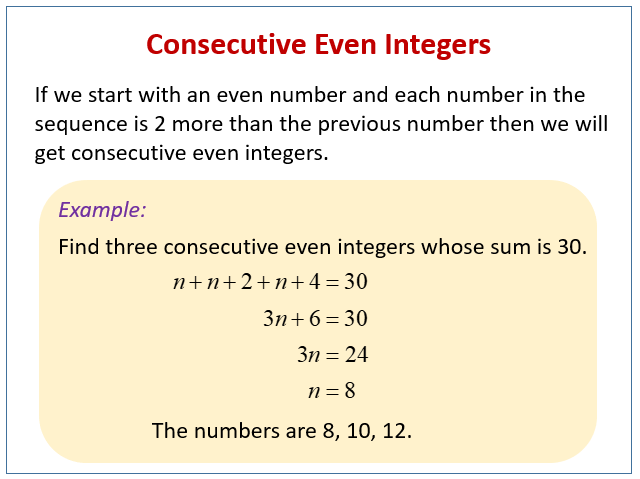Consecutive Even Integer Problems
Related Pages
Consecutive Integer Word Problems
Consecutive Odd Integer Problems
Other types of Algebra Word Problems
Integer Games
In these lessons, we will learn how to solve algebra word problems that involve consecutive even integers.
Consecutive integer problems are word problems that involve consecutive integers.
What are consecutive integers?
Consecutive integers are integers that follow in sequence, each number being 1 more than the previous number, represented by n, n + 1, n + 2, n + 3, …, where n is any integer.
For example: 23, 24, 25, …
What are consecutive even integers? If we start with an even number and each number in the sequence is 2 more than the previous number then we will get consecutive even integers.
For example: 16,18, 20, …
What are consecutive odd integers? If we start with an odd number and each number in the sequence is 2 more than the previous number then we will get consecutive odd integers.
For example: 33, 35, 37, …
We will now look at some examples of consecutive even integer problems.
The following diagram shows an example of consecutive even integer problem. Scroll down the page for more examples and solutions on how to solve consecutive even integer problems.

Printable & Online Algebra Worksheets
How to solve Consecutive Even Integer Word Problems?
Example: (Consecutive Even Integer)
John has a board that is 3 feet long. He plans to use it to make 4 shelves whose lengths are to be a series of consecutive even numbers. How long should each shelf be in inches?
Solution:
Step 1: Being consecutive even numbers we need to add 2 to the previous number.
Assign variables:
Let x = length of first shelf
x + 2 = length of second shelf
x + 4 = length of third shelf
x + 6 = length of fourth shelf
Step 2: Convert 3 feet to inches
3 × 12 = 36
Step 3: Sum of the 4 shelves is 36
x + x + 2 + x + 4 + x + 6 = 36
Combine like terms
4x + 12 = 36
Isolate variable x
4x = 36 – 12
4x = 24
x = 6
Step 4: Check your answer
6 + 6 + 2 + 6 + 4 + 6 + 6 = 36
The lengths of the shelves should be 6, 8, 10 and 12.
Answer: The lengths of the shelves in inches should be 6, 8, 10 and 12.
How to represent the sum of even and odd consecutive integers algebraically?
How to solve integer word problems that involve the sum of consecutive integers?
Examples:
- The sum of two consecutive integers is 99. Find the value of the smaller integer.
- The sum of two consecutive odd integers is 40. What are the integers?
- The sum of three consecutive even integers is 30. Find the integers.
How to solve algebra word problems that involve consecutive even integers?
Example:
Three consecutive even integers add up to 180. Find the largest of these three integers using a linear equation.
Example:
The largest of five consecutive even integers is 2 less than twice the smallest. Which of the following is the largest integer?
How to solve a consecutive even integer problem?
Consecutive odd integers are set up the exact same way.
Problem: If the first and third consecutive even integers are added, the result is 22 less than 3 times the second integer. Find the integer.
Consecutive Even Integer Story Problem
Problem: Find two consecutive integers such that the smaller added to four times the larger gives a sum of 28.
Try out our new and fun Fraction Concoction Game.
Add and subtract fractions to make exciting fraction concoctions following a recipe. There are four levels of difficulty: Easy, medium, hard and insane. Practice the basics of fraction addition and subtraction or challenge yourself with the insane level.

We welcome your feedback, comments and questions about this site or page. Please submit your feedback or enquiries via our Feedback page.